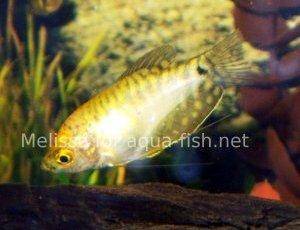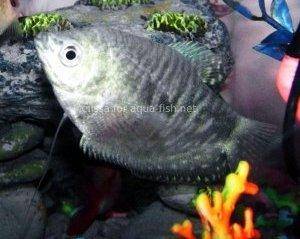Gourami Species: Care, Characteristics, and Varieties
Quick links
Brief Description
This page is a comprehensive guide to Gouramis, offering insights into their care, behavior, breeding, and various species. Gouramis are known for their vibrant colors, unique labyrinth organ, and fascinating breeding habits. Whether you're a beginner or an experienced aquarist, this article will provide valuable information on raising these beautiful and diverse fish.
Introduction to Gouramis
A very common freshwater fish is the Gourami, which is diversely represented in the aquarium industry under the Belontiidae, Osphronemidae, and Helostomidae families. These fish come from waters throughout Asia and Africa, including oxygen-poor roadside ditches and rice paddies. They all fall under the category of labyrinth fish because of their ability to breathe oxygen from the atmosphere above the water.
There are many types of Gouramis bred for the aquatic hobby, ranging in a wide variety of sizes, colors, and temperaments. Despite the different variations, most Gouramis are quite adaptable to different water conditions of temperature, hardness, and pH level. Optimum water conditions are wide-ranging, from soft to hard, with a temperature of 72 - 82°F (~ 22 - 28°C) and a pH range of 5.5-7.5.
One prominent trait that most Gouramis possess is their long, skinny pelvic fins, which they use like antennas on bugs or whiskers on a cat. The purpose of this feature is to feel their way through the water, especially in muddy, murky conditions, to find food and other objects. Most Gouramis prefer to swim in the middle to top waters of the aquarium and will coexist peacefully with bottom-dwelling fish. However, they can be semi-aggressive, especially males toward other males. Providing enough swimming and hiding space is key to managing their temperament.
Labyrinth Fish
Gouramis are labyrinth fish named for their organs comprised of maze-shaped tissue located above their gills that allow them to breathe oxygen from the air above the water. At the water’s surface, the Gourami will gulp in air which will then pass into the labyrinth organs. These respiratory organs contain blood vessels through which atmospheric oxygen can be absorbed from its gas form. Despite their air-breathing abilities, Gouramis can still absorb oxygen from the water they live in. In fact, these anabantids need oxygen from both the atmosphere and the water to survive.
The thing that sets them apart from other fish is that they have the ability to live in bodies of water that have a depleted oxygen supply. Among Gouramis, there are also bettas, paradise fish, and climbing perch that fall under the labyrinth fish category as well. The ability to breathe air not only allows these fish to live in waters with poor oxygen supply, but it also allows them to survive out of water for a period of time as long as their skin and gills remain moist. The climbing perch has the uncanny ability to use this skill to travel short distances across land.
Sexing Gouramis
It is very hard to sex most species of these fish when they are young. Once they are older, it is easier to tell males apart from females by looking at their dorsal fin. A male’s dorsal fin will be longer and pointier. In some species, the male will also have other distinguishing characteristics such as longer, flowing anal fins and more vibrant coloring.
Breeding
Most Gouramis are bubble nest builders when it comes to breeding. Some exceptions are the kissing gourami, who is an open-water spawner, and the chocolate gourami, who is a mouth-brooder. With bubble nest builders, the male will breathe air from the surface and dispense it through his gills. The mucus in his gills will trap the air as bubbles which then float to the surface. As he forms these bubbles, he will gather them together and form a nest up against plants using plant matter to hold it together. This is usually done in a calm area without too much current so that the delicate nest is not disturbed.
In the midst of building his nest, the male will take time to display himself for the female. He spreads his fins to make himself appear larger and he’ll show off for her by wiggling his body back and forth. By the time he is done building the nest, the female is usually ready to spawn. If the female is not ready to spawn when the male is done with his nest, he will attack her. If this happens, you will want to remove the female, or the male may kill her.
When the male and female are both ready to mate, the male will wrap his flexible body around the female in a tight embrace. When they are done mating, the female will lay her eggs. Most Gourami eggs are buoyant so they float to the top. The male gathers the eggs and tucks them up into the bubble nest and proceeds to build up the nest some more. As for those whose eggs aren’t buoyant, the male takes the job of catching them as they fall and then placing them up into the bubble layer.
The female will lay as many as 1,000 eggs depending on the quality of her health and her size. Once the eggs are all safely placed in the nest, the female is no longer needed, and the male chases her away. The care of the offspring is left to the male from this point on.
Raising the Young
After two days, the eggs will hatch and the fry may start to fall out of the nest. The father will catch any who fall and replace them back into the bubbles. After 5 days, the fry become free-swimming. This is the point at which the father is no longer interested in caring for the young and he is likely to eat them if he finds them. You’ll want to be sure to quickly remove the male at this point. In order to feed Gourami fry, you’ll want to use liquid fry food for the first week, after which you’ll be able to feed them newly hatched brine shrimp and microworms. Fry powders can also be fed to the fry, but keep in mind a well-balanced diet also includes live foods. Feeding small amounts two to three times daily can be more beneficial than larger once-a-day feedings because the fry are so small. Subsequently, because of their size, you’ll want to be extremely cautious of what sort of filter you use. They are so small that even the slightest current might suck them up or kill them.
Common Variations
| Common name | Family | Species | Mature Size | Colouration and Markings | Brief Description |
|---|---|---|---|---|---|
| Blue or Three spotted Gourami | Belontiidae | Trichogaster trichopterus | 4 inches (10.16 cm) | Light silvery blue in colour with two spots on each side. Its third spot is its eye, thus the name. | The aquarium strains grow slightly larger and are slightly more aggressive than the wild version of this species. |
| Giant Gourami | Osphronemidae | Osphronemus goramy | 28 inches (71.12 cm) | Dark grey and silver stripes when they are young while adults have contrasting grey scales with dark and light spots on the head. | The giant gourami is ideal for use as a food fish because of its ease of keeping and also the quick rate at which it matures. |
| Pearl Gourami | Belontiidae | Trichogaster leeri | 4 inches | Silvery gold body with lots of white, pearlescent spots and a black, uneven line from nose to tail. Males have bright orange under chin, chest and anal fin. | This gourami does not reach sexual maturity until it reaches full adult maturity. |
| Golden Gourami | Belontiidae | Trichogaster trichopterus sumatranus | 4.5 inches (10.16 cm) | Golden coloured body with bright yellow fins and a silvery belly. | This species is aquarium bred and not found in the wild. |
| Kissing Gourami | Heolstomatidae | Helostoma temminckii | 8 inches (20.32 cm) | The colour of this aquarium bred version is a slivery-pink while the wild caught variation is silvery-green. | This gourami does not have filaments for pelvic fins. It has pelvic fins normal to most other fish. The mouth on mouth behaviour that gives this species the “kissing” name is not necessarily a display of affection. This action can also represent a trial of strength. |
| Dwarf Gourami | Belontiidae | Colisa lalia | 2 inches (5.08 cm) | Powder blue body with bright reddish-orange vertical stripes. The under side of this fish can be turquoise if healthy. | Females are noticeably less coloured than the males of this species. |
| Chocolate Gourami | Belontiidae | Sphaerichhys osphromenoides | 3.5 inches (8.89 cm) | Chocolate brown body with a 90° cream coloured band starting at the top of the head to the eye and extending out to the pointed tip of a mouth. Additional cream coloured bands located across the body. | This species is an exception to the bubble nest breeders. Instead they are mouth-brooders who are very demanding of water conditions and do not do well with other species. |
Gourami Species in Our Database
- Giant Gourami (Osphronemus goramy)
- Pearl Gourami (Trichogaster leeri)
- Chocolate Gourami (Sphaerichhys osphromenoides)
- Dwarf Gourami (Colisa lalia)
- Blue Gourami (Trichogaster trichopterus)
- Moonlight Gourami (Trichopodus microlepis)
- Honey Gourami (Trichogaster chuna)
- Thick-lip Gourami (Trichogaster labiosa)
- Licorice Gourami (Parosphromenus deissneri)
- Giant Red Fin Gourami (Osphronemus laticlavius)
- Frail Gourami (Ctenops nobilis)
- Banded Gourami (Trichogaster fasciata)
- Snakeskin Gourami (Trichopodus pectoralis)
- Kissing Gourami Breeding and Care (Helostoma temminckii)
Pictures
Citations and Resources
- Dorling Kindersley Handbooks: Aquarium Fish by Dick Mills
- Aquarium Fish by Ulrich Schliewen
- The Ultimate Aquarium by Mary Bailey and Gina Sandford
- The Encyclopedia of Aquarium Fish by Dick Mills




